人教课标版英语选修六Unit1Reading 教学设计
- 格式:doc
- 大小:29.50 KB
- 文档页数:3

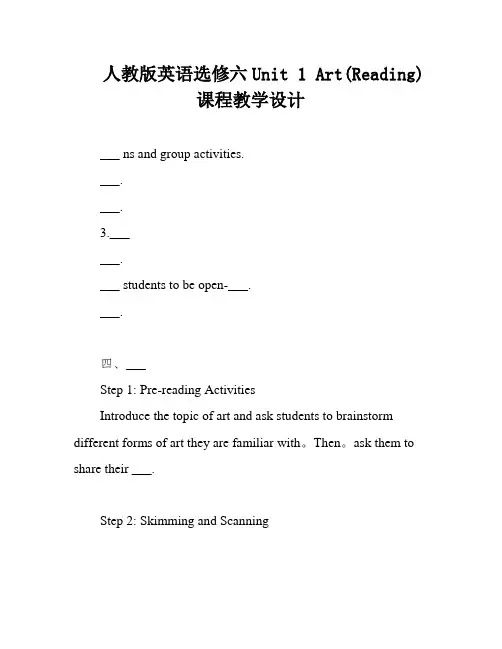
人教版英语选修六Unit 1 Art(Reading)课程教学设计___ ns and group activities.___.___.3.______.___ students to be open-___.___.四、___Step 1: Pre-reading ActivitiesIntroduce the topic of art and ask students to brainstorm different forms of art they are familiar with。
Then。
ask them to share their ___.Step 2: Skimming and ScanningAsk students to read the passage quickly and identify the main ideas of each paragraph。
Then。
have them scan the text for specific n related to the new words and ___.Step 3: Group nDivide the class into groups and assign each group a specific art movement or style to analyze。
Have them discuss the characteristics of the style。
its major artists and works。
and the ___ it emerged.Step 4: ___ AssignmentsAsk students to write a short ___ from the text and their own research to support their arguments.Step 5: nsHave students present their findings from the group n and ___ them to use visual aids such as images and ___.Step 6: nAsk ___ them to think about how they can apply this knowledge to their own lives and future careers.五、Assessment and ___Assess students’ ___ to help students improve their reading and critical ___.1.Understanding the cultural background and significance of ___.2.___ paintings.During the warm-up。
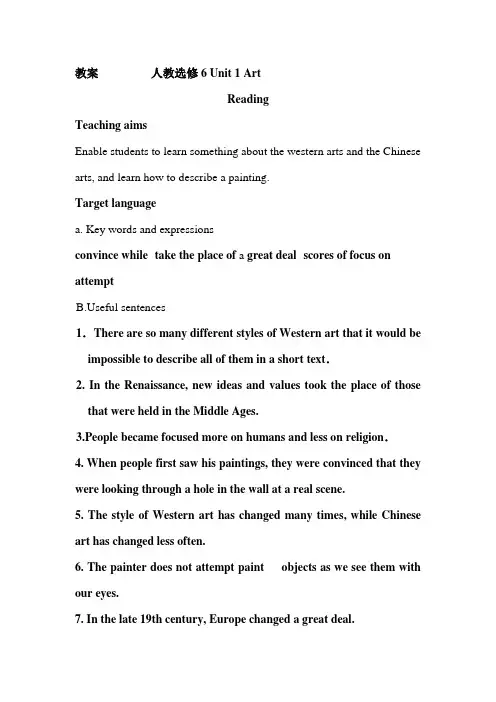
教案人教选修6 Unit 1 ArtReadingTeaching aimsEnable students to learn something about the western arts and the Chinese arts, and learn how to describe a painting.Target languagea. Key words and expressionsconvince while take the place of a great deal scores of focus on attempteful sentences1.There are so many different styles of Western art that it would be impossible to describe all of them in a short text.2. In the Renaissance, new ideas and values took the place of thosethat were held in the Middle Ages.3.People became focused more on humans and less on religion.4. When people first saw his paintings, they were convinced that they were looking through a hole in the wall at a real scene.5. The style of Western art has changed many times, while Chinese art has changed less often.6. The painter does not attempt paint objects as we see them with our eyes.7. In the late 19th century, Europe changed a great deal.8. Nowadays, there are scores of modern art styles.Learning ability goalsEnable the students to learn the different styles of the western arts. Teaching important pointsHow to make students tell the characteristics, styles of the western arts.Teaching aidsA projector, a tape-recorder and a blackboardTeaching proceduresStep1 BrainstormingT: How much do you know about art? Have you ever been to an art gallery? Do you find your visit interesting? What can you think of when looking at the word “art”?Slide showPaintings art museumsart painters artistsart works art galleries The Renaissance Mona LisaStep2 Pre-readingT: Today we will learn more about the western art, now please look at the screen.Slide show1. Have you visited art galleries?2. What are the names of some famous Western or Chinese artists?3. The following paintings are all very famous. Can you guess their names and their painters? What styles they belong to?Step3 Fast readingSlide show1. Read the text quickly and answer the following questions.1.What’s the main idea of the text?2.How many styles are mentioned in the passage and what are theirnames?Keys:1. The style of Western art has changed a lot with time going by.2. Four. They are: The Middle Ages, The Renaissance, Impressionism and Modern art.2. Listen to the text carefully, fill in the blanks, and pay attention to the time expressions.1. The style of Western art has changed____________, while Chineseart has changed________.2. China, unlike Europe, hasfollowed___________________________.3. This text will describe only a few of the main styles starting___________________.4. During the Middle Ages, the main aim of painters was to_________5. Things had begun to change ________6._______________________,____________________took the place of those that were held in the Middle Ages.7. One of the most important discoveries ___________________was how to draw things in perspective.8. The first person to use perspective in his paintings was_________.9. ____________________________they were convinced they were looking...10.____________________, oil paints were also developed,..11._____________________,Europe changed a great deal…12. ________, most people hated this new style of painting.13._________________________, the impressionists’ paintings were controversial…14.__________, there are scores of modern art styles…15. It is interesting to predict what styles of painting there willbe_____Keys:1. many times less often2. similar way of life for a very long time.3. from the 5th century AD4.represent religious themes5. by the13th century6.In the Renaissance new ideas and values7.during this period8.Masaccio in 14289. When people first saw his paintings 10.During the Renaissance 11.In the late 19th century 12.At first13.At the time they were created 14.Nowadays 15.in the future Step 4 Detailed reading1. Read the passage in details, discuss in groups and fill in the table2. Read the passage again and do Exercise 2 on Page3. T&F Questions.1. Western art has changed very little over the last 17 centuries.2. Painters in the Middle Ages painted mainly religious subjects.3. Paintings in the Middle Ages were very realistic.4. Renaissance painters tried to paint things in a realisticway.5. Two important discoveries in the Renaissance period were oil paints and drawing in perspective.6. Impressionists painted their pictures mainly indoors.7. At first people did not like the impressionists’ paintings.8. Modern art began with the impressionists.Now enjoy some of the very famous arts in the western history, and tell their names, painters and styles.Keys: F T F T F T TStep 5 QuestionsSlide showWhat are the differences between the development of Western art and Chinese art?The style of Western art has changed many times since the 4th Century AD. Chinese art, on the other hand, has changed less often, and most traditional styles still remain. Art is influenced by the way of life and beliefs of the people. Unlike Europe, China has been united by language, writing, religion (especially Taoism and Buddhism) dynastic rule and the philosophy of Confucianism for a very long time. Also, the past is more valued in China than it is in the West.Step 6 Discussion1. Predict what styles of painting there will be in the future.2. What will you paint in the future if you are a painter?Step 7 Homework1. Review and retell the text, pay attention to some key words, useful expressions and difficult sentences.2. Choose one of the above paintings and write a short description of it, including its style, its painter and your understanding.。

Unit 1 Book 6教学设计稿The Second Period ReadingTeaching goals 教学目标Target language 目标语言重点词汇和短语realistic, abstract, religion,religious, sculpture, gallery, belief, consequent, consequently, aim, symbol, value, focus, possession, convince, impressionism, impressionist, shadow, ridiculous, nowadays, attempt, predict, the Renaissance,fbcus on, a great deal, scores ofa.重点句式There are so many ... (hat it would be impossible to ... PlPeople became focused more on ... and less on ... P2If the rules of perspective had not been discovered, people would not have been able to paint... P21.Ability goals Enable the students to talk about (he short history of Western painting.2.Learning ability goals Help the students learn how to talk about the short history of Western painting. Teaching important & difficult pointsEnable the students to (alk about (heir opinions about different stylesof Western art.leaching methodsSkimming and scanning; individual, pair or group work; discussion.Teaching aidsA recorder, a computer, a projector and some famous paintings.Teaching procedures & ways 教学过程与方式Step I Lead-in Have you found any changes in our school? Step II Warming UpFirst, please match some new words in Column A with the correct English meanings in Column B. Show them on the screen.A Ba. realistic 1. accurate, minuteb. abstract 2. state or fact of existingc. existence 3. being in thought but having a physical or practical existenced. detailed 4. lifelike, true to lifee. religious 5. classical, of old beliefsf. traditional 6. sincere to believe in a god or godsI'd like you to look at the paintings in this unit, and then work in groups of 4 to discuss the questions in Warming Up.Step III Pre-reading Get the students to discuss the questions in Prc-rcading in pairs. Then check the answers with the whole class.1.Do you ever visit art galleries? What kind of paintings have your ever seen?2.Can you speak out the names of some famous Western artists and tell me in which centuiy they lived? Step IV Reading Task I ScanningShow some questions on the screen.1.What were the artists interested in from 5lh(o 15th century AD?2.How did Masaccio paint his paintings?3.Why did the impressionists have to paint quickly?Task 2 SkimmingLet the students read the passage again and get (he main idea of it. Then complete lhe following charton their own. And check the answers with the whole class.Let's explain some sentences.1.There are so many ... that it would be impossible to...This sentence means that there are too many different styles of Western art to introduce in a short passage.2.People became focused more on humans and less on religion.It tells us that people began to pay more attention to humans than religion.3.If the rules of perspective had not been discovered, people would not have been able to paint...This sentence means that people discovered the rules of perspective, so that they painted such realistic pictures.4.During the Renaissance oil paints were also developed, which made colors look ...That is to say, during (he Renaissance oil paintings were so advanced that colors looked richer and deeper.5.At the time they were created, the impressionists' paintings were controversial but today they arc accepted as the beginning of what we now call “modern art''.When the impressionists started to paint in their own way, some people did not accept their paintings. However, nowadays people consider them as the beginning of (he Modern Art.Step V Comprehending Let the students read the passage again and deal with the Exercises I & 2 in Comprehending. Step VI.课文重点难点解析There are so many different styles of Western art that it would be impossible to describe all of them in a short text. Plso ... that...如此以致于;so之后可接形容词、副词或加修饰语的名伺:e.g. This isso interesting a book that we all like to read it.He had so many falls that he was black and blue all over.a.当不定式、动名词、从句等结构用作主语时,为了避免“头重脚轻",往往用it作形式主语而把真正的主语放在句子末尾。
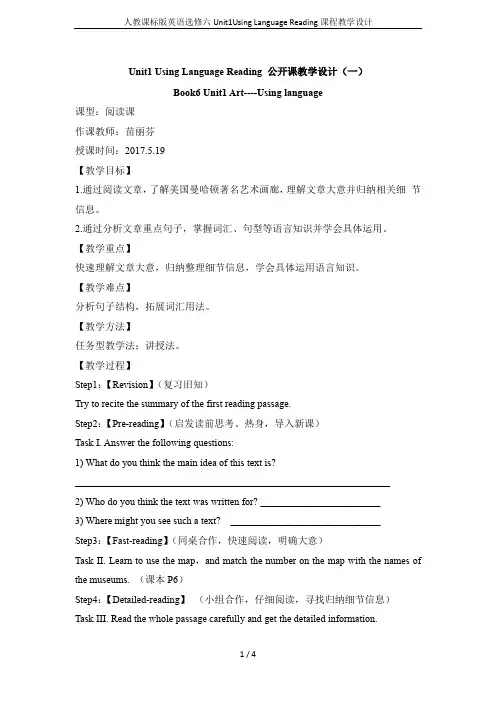
Unit1 Using Language Reading 公开课教学设计(一)Book6 Unit1 Art----Using language课型:阅读课作课教师:苗丽芬授课时间:2017.5.19【教学目标】1.通过阅读文章,了解美国曼哈顿著名艺术画廊,理解文章大意并归纳相关细节信息。
2.通过分析文章重点句子,掌握词汇、句型等语言知识并学会具体运用。
【教学重点】快速理解文章大意,归纳整理细节信息,学会具体运用语言知识。
【教学难点】分析句子结构,拓展词汇用法。
【教学方法】任务型教学法;讲授法。
【教学过程】Step1:【Revision】(复习旧知)Try to recite the summary of the first reading passage.Step2:【Pre-reading】(启发读前思考、热身,导入新课)Task I. Answer the following questions:1) What do you think the main idea of this text is?_______________________________________________________________2) Who do you think the text was written for? ________________________3) Where might you see such a text? ______________________________Step3:【Fast-reading】(同桌合作,快速阅读,明确大意)Task II. Learn to use the map,and match the number on the map with the names of the museums. (课本P6)Step4:【Detailed-reading】(小组合作,仔细阅读,寻找归纳细节信息)Task III. Read the whole passage carefully and get the detailed information.【Further-learning】(独立深入学习,观看视频,感知了解更多文章信息)Step5:【Sentences Analysis】(小组合作讨论,语言点学习,拓展词汇、句型)1.Many art lovers would rather visit this small art gallery than any other in New York. 翻译:_______________________________________________________________ 拓展:比起做某事更愿意做某事3种表达方式:____________________________________________________________________ 2. Henry Clay Frick, died in 1919, leaving his house, furniture and art collection to the American people.翻译:_______________________________________________________________ 拓展:1)make/have a collection of…收藏2)父母在事故中丧生,留下了儿子孤单一人。
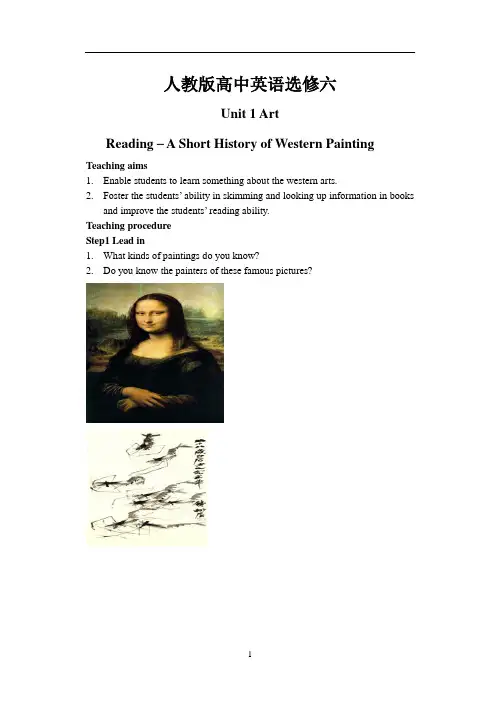
人教版高中英语选修六Unit 1 ArtReading – A Short History of Western PaintingTeaching aims1.Enable students to learn something about the western arts.2.Foster the students’ ability in skimming and looking up information in booksand improve the students’ reading ability.Teaching procedureStep1 Lead in1.What kinds of paintings do you know?2.Do you know the painters of these famous pictures?Step2 Fast reading1. In what order is the passage organized?2. How many western styles are mentioned in the passage and what are they? Step3 Careful readingPara.1:1. What is art influenced?2. Did western art change a lot?The Middle Ages1.What is the aim of painters during the Middle Ages?2. What were the artists not interested in and what were they interested in ? The Renaissance1.In the Renaissance, what did people focus on?2. How did Masaccio paint his paintings?3. What kind of paints were developed at this time?Impressionism1.What happened to Europe in the late 19th century?2. What did the impressionists want to show?3. Why did the impressionists have to paint quickly?4. Why did many people become very angry about the paintings?Modern Art1.What is impressionist paintings accepted as?2.What would have happened if there had been no impressionists?3.What were the qualities of modern art?Step4 Post-reading: True/false questionsStep 5 Writing你的朋友小明最近在学习西方绘画历史方面遇到了难题。
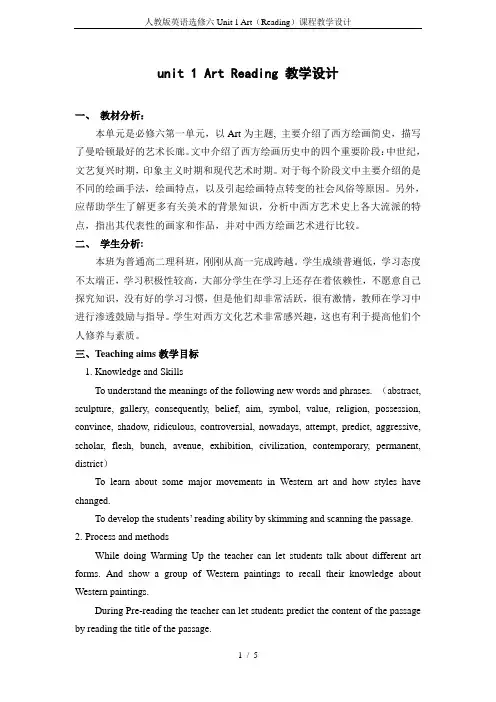
unit 1 Art Reading 教学设计一、教材分析:本单元是必修六第一单元,以Art为主题, 主要介绍了西方绘画简史,描写了曼哈顿最好的艺术长廊。
文中介绍了西方绘画历史中的四个重要阶段:中世纪,文艺复兴时期,印象主义时期和现代艺术时期。
对于每个阶段文中主要介绍的是不同的绘画手法,绘画特点,以及引起绘画特点转变的社会风俗等原因。
另外,应帮助学生了解更多有关美术的背景知识,分析中西方艺术史上各大流派的特点,指出其代表性的画家和作品,并对中西方绘画艺术进行比较。
二、学生分析:本班为普通高二理科班,刚刚从高一完成跨越。
学生成绩普遍低,学习态度不太端正,学习积极性较高,大部分学生在学习上还存在着依赖性,不愿意自己探究知识,没有好的学习习惯,但是他们却非常活跃,很有激情,教师在学习中进行渗透鼓励与指导。
学生对西方文化艺术非常感兴趣,这也有利于提高他们个人修养与素质。
三、Teaching aims教学目标1. Knowledge and SkillsTo understand the meanings of the following new words and phrases. (abstract, sculpture, gallery, consequently, belief, aim, symbol, value, religion, possession, convince, shadow, ridiculous, controversial, nowadays, attempt, predict, aggressive, scholar, flesh, bunch, avenue, exhibition, civilization, contemporary, permanent, district)To learn about some major movements in Western art and how styles have changed.To develop the students’ reading ability by skimming and scanning the passage. 2.Process and methodsWhile doing Warming Up the teacher can let students talk about different art forms. And show a group of Western paintings to recall their knowledge about Western paintings.During Pre-reading the teacher can let students predict the content of the passage by reading the title of the passage.Reading and comprehending: the teacher asks students to read the passage quickly to get its structure. After that, the teacher lets students read carefully to get more detailed information.Post-reading: let student retell the passage in their own words at the end of the class.3.Emotion, attitude and valueTo stimulate students’ sense of beauty and the ability of understanding, enjoying and creating beauty.To develop students’ sense cooperation learning.四、Teaching important points教学重点1. Enable the students to grasp the new words and impressions.2. Try to get the main idea of the text and improve the students’ reading abilities.五、Teaching difficult points教学难点1. Help the students learn how to talk about the short history of Western painting.2. Enable the students to talk about their opinions about different styles of Western art.六、Teaching aids 教具The multimedia , blackboard七、Teaching method教学方法Task-Based Language Teaching, Skimming and scanning, Discussion八、Teaching procedures教学过程Step 1. GreetingsGood morning, everyone! So happy to see you here.Step 2. RevisionLast class, we have learned the new words, now let us have a short review. Please open your book and turn to page 89, and read follow me.设计意图:本班学生基础较差,基础的单词必须每节课都巩固,上课读一遍,加强记忆,有助于更好理解课文,并且为以后学习打好基础。
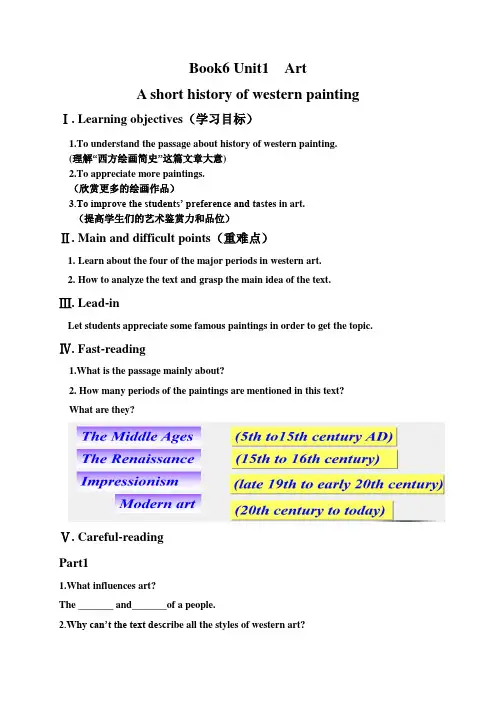
Book6 Unit1 ArtA short history of western painting Ⅰ. Learning objectives(学习目标)1.To understand the passage about history of western painting.(理解“西方绘画简史”这篇文章大意)2.To appreciate more paintings.(欣赏更多的绘画作品)3.To improve the students’ preference and taste s in art.(提高学生们的艺术鉴赏力和品位)Ⅱ. Main and difficult points(重难点)1.Learn about the four of the major periods in western art.2.How to analyze the text and grasp the main idea of the text.Ⅲ. Lead-inLet students appreciate some famous paintings in order to get the topic. Ⅳ. Fast-reading1.What is the passage mainly about?2. How many periods of the paintings are mentioned in this text? What are they?Ⅴ. Careful-readingPart11.What influences art?The _______ and_______of a people.2.Why can’t the text desc ribe all the styles of western art?Part2 Reading for detailsⅥ.Post-readingDo an exercise ——Draw &GuessⅦ.SummaryⅧ. HomeworkWrite an article to tell us your choice that you choose one for your family. It should include the following points:1.Your choice2.Features of the painting3.The period that it belongs to(no less than 100)。
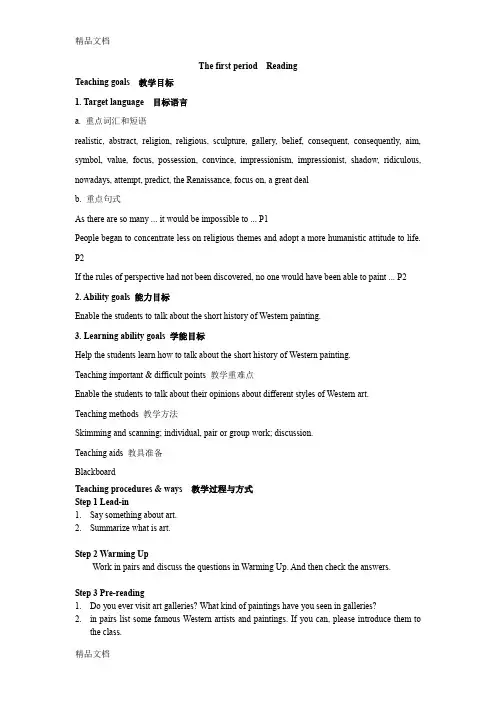
The first period ReadingTeaching goals 教学目标1. Target language 目标语言a. 重点词汇和短语realistic, abstract, religion, religious, sculpture, gallery, belief, consequent, consequently, aim, symbol, value, focus, possession, convince, impressionism, impressionist, shadow, ridiculous, nowadays, attempt, predict, the Renaissance, focus on, a great dealb. 重点句式As there are so many ... it would be impossible to ... P1People began to concentrate less on religious themes and adopt a more humanistic attitude to life. P2If the rules of perspective had not been discovered, no one would have been able to paint ... P2 2. Ability goals 能力目标Enable the students to talk about the short history of Western painting.3. Learning ability goals 学能目标Help the students learn how to talk about the short history of Western painting.Teaching important & difficult points 教学重难点Enable the students to talk about their opinions about different styles of Western art.Teaching methods 教学方法Skimming and scanning; individual, pair or group work; discussion.Teaching aids 教具准备BlackboardTeaching procedures & ways 教学过程与方式Step 1 Lead-in1.Say something about art.2.Summarize what is art.Step 2 Warming UpWork in pairs and discuss the questions in Warming Up. And then check the answers.Step 3 Pre-reading1.Do you ever visit art galleries? What kind of paintings have you seen in galleries?2.in pairs list some famous Western artists and paintings. If you can, please introduce them tothe class.Step 4 Reading2.Read the text carefully again and answer the questions.(1) What were the artists interested in from 5th to 15th century AD?(2) How did Masaccio paint his paintings?(3) Why did the impressionists have to paint quickly?3. According to the text, finish exercise 3 on page 3 by yourselves. Then check the answers.4. What is the writing style of the passage?------The passage is a historical narrative article. It briefly introduces the main features of different Western painting styles during the main periods of times. It also analyzes why and how the styles changed. The short history of Western painting styles is described clearly and vividly, which gives the readers deep impression.5. How about its writing characteristic?------The writing characteristic of it is: Arranged well in the order of time; Catch the features of people and things and use adjectives very exactly; Lay the stress on the main subjects and purpose, writing details and briefs properly; Insert the typical paintings to make the passage more vivid and lively.Step 5 Homework1. Underline the time expressions in the reading passage.2. Retell the passage with the help of the chart about the text.3. Memorize the new words and expressions.。
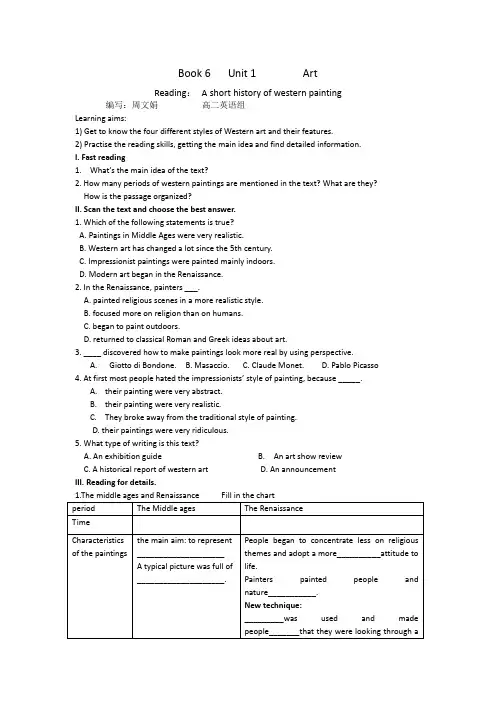
Book 6 Unit 1 ArtReading:A short history of western painting 编写:周文娟高二英语组Learning aims:1) Get to know the four different styles of Western art and their features.2) Practise the reading skills, getting the main idea and find detailed information.I. Fast reading1.What’s the main idea of the text?2. How many periods of western paintings are mentioned in the text? What are they? How is the passage organized?II. Scan the text and choose the best answer.1. Which of the following statements is true?A. Paintings in Middle Ages were very realistic.B. Western art has changed a lot since the 5th century.C. Impressionist paintings were painted mainly indoors.D. Modern art began in the Renaissance.2. In the Renaissance, painters ___.A. painted religious scenes in a more realistic style.B. focused more on religion than on humans.C. began to paint outdoors.D. returned to classical Roman and Greek ideas about art.3. ____ discovered how to make paintings look more real by using perspective.A.Giotto di Bondone.B. Masaccio.C. Claude Monet.D. Pablo Picasso4. At first most people hated the impressionists’ style of painting, because _____.A.their painting were very abstract.B.their painting were very realistic.C.They broke away from the traditional style of painting.D. their paintings were very ridiculous.5. What type of writing is this text?A. An exhibition guideB. An art show reviewC. A historical report of western artD. An announcementIII. Reading for details.1) What are the characteristics of Impressionism?The pictures were painted________________.They were to show_____________________________________________They were not ___________________those of earlier paintings.2) What are the characteristics of modern art?One the one hand, some modern art is ____________.Painters concentrate on____________of the object, using color _____and____.On the other hand, some paintings of modern art are so________that they look like photographs.IV Summary: Fill in the blanksThis text describes four ________(period) of Western art. During the Middle Ages, the main aim of conventional painters was to represent ______(religion )themes. During the Renaissance, people concentrated less___religious themes and adopted a more humanistic attitude ________life. Perspective paintings even__________(convince) people that they were looking through a hole in the wall. Oil paints were developed, _______made the colors richer and deeper. In the late 19th century, social changes _____(lead) to new painting styles like Impressionism. Impressionists were the first ________(work) outdoors and painted changes in light. Their paintings were not as __________(detail) as those before, but are accepted as the beginning of modern art. Some modern art is abstract ________ some of the paintings are so realistic.V. Make a dialogueIf you were to open a new gallery for our school, what kind of art would you prefer to put in and why? Share your opinions with your partners and make a dialogue .A: If you could put in any paintings you like, which kind of art would you like to choose …?B: I would like… …, as …..What’s your preference?A: I’m not fond of… I’d prefer.. Because…B:….(Realistic/abstract/religious/modern/colorful/natural/wonderful/nice /masterpieces/detailed.) (Traditional Chinese Paintings/ The Middle Ages/ The Renaissance/ Impressionism/ Modern Art/cartoons)VI HomeworkWrite a letter to the headmaster giving your suggestions and reasons for starting this new art gallery. (100120words)Dear sir,I wish to make a suggestion about….. The gallery would provide….If you were to….., I believe……….It’s a good idea to….I do hope you will consider my suggestions.Yours faithfully,Li HuaExtensive ReadingMasaccio(December 21, 1401 –autumn 1428), was the first great Italian painter of the Italian Renaissance. Masaccio was the best painter of his generation because of his skill at recreating lifelike figures and movements as well as a convincing sense of threedimensionality(三维).Masaccio died at twentysix. Despite his brief career, he had a profound(深远的) influence on other artists. He was one of the first to use linear perspective(直线透视法)in his painting, employing techniques such as vanishing point (灭点)in art for the first time.Perspective The two most characteristic features(特点) of perspective are that objects are drawn: smaller as their distance from the observer increases;Foreshortened: the size of an object's dimensions(尺寸)along the line of sight are relatively shorter than dimensions across the line of sightA drawing has onepoint perspective containing only one vanishing point on the horizon line. This type of perspective is typically used for images of roads, railway tracks, hallways, or buildings. A drawing has twopoint perspective containing two vanishing points on the horizon line. Twopoint perspective can be used to draw the objects: looking at the corner of a house. Threepoint perspective is usually used for buildings seen from above (or below). Looking up at a tall building is a mon example of the third vanishing point. This time the third vanishing point is high in space.Leonardo da Vinci was an Italian painter, sculptor, architect, musician, mathematician, engineer, inventor and writer. He is widely considered to be one of the greatest painters of all time and perhaps the most diversely talented(多才多艺) person. Among his works, the Mona Lisa is the most famous and The Last Supper the most reproduced religious painting of all time.Raphael was an Italian painter and architect of the High Renaissance(文艺复兴时期盛期). His work is admired for its clarity(清晰)of form and ease of position(构图). Together with Michelangelo and Leonardo da Vinci, he forms the traditional three great masters of that period.(文艺复兴三杰) The best known work is The School of AthensMichelangelo was an Italian sculptor, painter, architect, poet, and engineer of the High Renaissance who had an unparalleled(空前的)influence on the development of Western art. Michelangelo was considered the greatest living artist in his lifetime. His output in every field during his long life was remarkable. He is the bestdocumented artist of the 16th century. Two of his bestknown works, the Pietà and David, were sculpted before he turned thirty. Michelangelo also created one of the most influential works in the history of Western art: The Last Judgment. ImpressionismOscarClaude Monet was a founder of French Impressionist painting, expressing his perceptions(感知) before nature. The term "Impressionism" came from the title of his painting Impression, Sunrise, which was exhibited in 1874Vincent Willem van Gogh was a PostImpressionist painter of Dutch origin whosework—notable for its rough beauty, emotional honesty, and bold(大胆的) color—had a farreaching(深远的)influence on 20thcentury art.. His famous works Still Life: Vase with Twelve Sunflowers, The Starry NightModern artPablo Picasso ( 25 October 1881 – 8 April 1973), was a Spanish painter, sculptor, poet and playwright who spent most of his adult life in France. He was one of the greatest and most influential artists of the 20th century. Among his most famous works are Guernica(1937), a portrayal of the Bombing of Guernica by the German and Italian airforces at the behest of the Spanish nationalist government during the Spanish Civil War.1. What are the two features of perspective?2. What are three great masters of the Renaissance?3. Where does the term “ Impressionism” e form?。
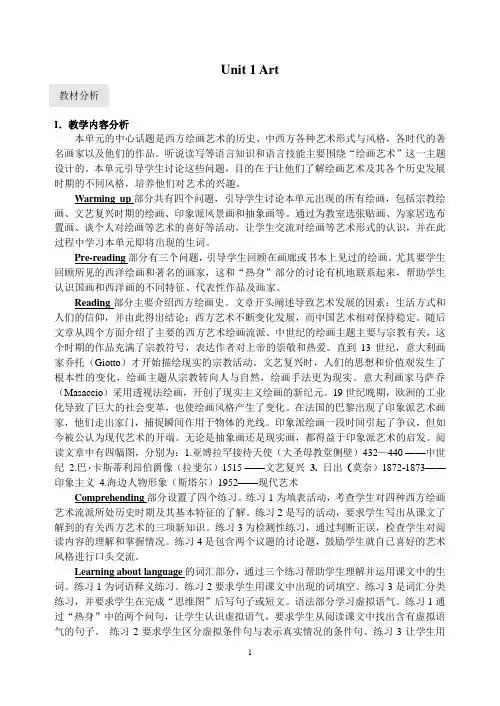
Unit 1 Art教材分析I.教学内容分析本单元的中心话题是西方绘画艺术的历史、中西方各种艺术形式与风格,各时代的著名画家以及他们的作品。
听说读写等语言知识和语言技能主要围绕“绘画艺术”这一主题设计的。
本单元引导学生讨论这些问题,目的在于让他们了解绘画艺术及其各个历史发展时期的不同风格,培养他们对艺术的兴趣。
Warming up部分共有四个问题,引导学生讨论本单元出现的所有绘画,包括宗教绘画、文艺复兴时期的绘画、印象派风景画和抽象画等。
通过为教室选张贴画、为家居选布置画、谈个人对绘画等艺术的喜好等活动,让学生交流对绘画等艺术形式的认识,并在此过程中学习本单元即将出现的生词。
Pre-reading部分有三个问题,引导学生回顾在画廊或书本上见过的绘画。
尤其要学生回顾所见的西洋绘画和著名的画家,这和“热身”部分的讨论有机地联系起来,帮助学生认识国画和西洋画的不同特征、代表性作品及画家。
Reading部分主要介绍西方绘画史。
文章开头阐述导致艺术发展的因素:生活方式和人们的信仰,并由此得出结论:西方艺术不断变化发展,而中国艺术相对保持稳定。
随后文章从四个方面介绍了主要的西方艺术绘画流派。
中世纪的绘画主题主要与宗教有关,这个时期的作品充满了宗教符号,表达作者对上帝的崇敬和热爱。
直到13世纪,意大利画家乔托(Giotto)才开始描绘现实的宗教活动。
文艺复兴时,人们的思想和价值观发生了根本性的变化,绘画主题从宗教转向人与自然,绘画手法更为现实。
意大利画家马萨乔(Masaccio)采用透视法绘画,开创了现实主义绘画的新纪元。
19世纪晚期,欧洲的工业化导致了巨大的社会变革,也使绘画风格产生了变化。
在法国的巴黎出现了印象派艺术画家,他们走出家门,捕捉瞬间作用于物体的光线。
印象派绘画一段时间引起了争议,但如今被公认为现代艺术的开端。
无论是抽象画还是现实画,都得益于印象派艺术的启发。
阅读文章中有四幅图,分别为:1.亚博拉罕接待天使(大圣母教堂侧壁)432—440 ——中世纪 2.巴۰卡斯蒂利昂伯爵像(拉斐尔)1515 ——文艺复兴3. 日出(莫奈)1872-1873——印象主义4.海边人物形象(斯塔尔)1952——现代艺术Comprehending部分设置了四个练习。
Unit1 阅读课教学设计人教版英语选修六Unit 1 Art (Warming-up & Reading)Teaching Aims:1. To introduce the definition and the forms of art to the students;2. To improve the basic reading skills of the students;3. To compare the differences between Chinese painting and Western painting;4. To develop the speaking skills of the students.Teaching Important and Difficult Points:1. How to have a clear understanding of the definition and forms of art;2. Learn about the main idea of the passage and find out the key information to each period;3. Try to analyze the differences between Chinese painting and Western painting in simple words;4. Improve the students’ ability of appreciation of art.Teaching method:1. Skimming and scanning;2. Individual, pair or group work;3. Discussing and speakingTeaching aids:Computer, projector and multimediaTeaching Process:Step 1 Lead-in (2 minutes)Good morning boys and girls, we have learned the important words and expressions of this unit and today we will come to the reading part. As we all know, the topic of this unit is art, so I want to ask all of you a question “What is art?” Before answering the question, let’s enjoy two famous saying about art.Showing the two famous saying about art on the PPT screen:① Art is long, and time is fleeting. --- Longfellow;艺术是永恒的,时间则是转瞬即逝的。
Unit1 Using Language Reading 名师教学设计(一)M6U1 (Using Language)The Best of Manhattan’s Art GalleriesSchool: Fuzhou No. 1 High SchoolName: Ye Xiuxiu福州一中叶秀秀Teaching Aims:Learn the skill of scanning.Learn the expressions of preferences and structures to introduce a place.Write a brief introduction to a museum.Introduce a place to visitors orally.Teaching difficult points:1. The background and features of the five galleries.2. How to introduce a place to a new comer.Teaching Aids:PowerPoint Presentation, handout, video, the mobile appTeaching Procedures:I. Pre-readingWatch a short video and think about what your senior is showing.After watching the video, answer the question: What’s she showing to us?II. Reading1. Task OnePredictingLook at the title of the passage to predict what the passage we are going to read is about.2. Task TwoScanningScan the passage and match the numbers on the map with the names of the museums. Which art gallery is not mentioned in the video? Why?3. Task ThreeDetailed ReadingRead the passage in the limited time on P6 and complete the chart on P7 with the information from the reading passage.Figure out the features of four art galleries.4. Task FourRead for writingScan the passage and circle all the expressions of preferences mentioned in it, including those expressions you like. Figure out the meanings of these expressions. III. Post reading1. Task OneListen for writingWatch a short video of Whitney Museum of American Art and introduce the last art gallery that Shu Lin has missed, using those expressions we have learned today. Founder: Gertrude Vanderbilt Whitney格特鲁德范德比尔特惠特尼(Lady Whitney)[ˈɡə:tru:d][ˈvændəbilt]Founding time: 1931It was the first museum to focus exclusively on art and artists of the United States.It moved to the border of the Hudson River in 2015. It has been moved three times. 2. SpeakingNext year comes the two hundredth anniversary of our school. Shu Lin is going to bring some foreign friends to our school.Ask the students to choose one place to introduce from the followings according to their preference. Some information given to the students:Library: Tongruo English Library (more than 14,000 original English books),the Third Library Observatory(天文台): A telescope and other equipment (one million yuan in total)Gymnasium: a newly-built fitness centerDear friends,Welcome to Fuzhou No. 1 High School. 2017 is the two hundredth anniversary of ourschool. I’m glad to show you around our beau tiful campus. _____________________Homework:1. Review the expressions of preferences and structures to introduce a place.2. Do the listening exercises on P7.3. Choose from the supplemental materials offered to you and know more about art galleries.4. Enjoy the video, Art City, New York in your spare time.。
选修6第一单元Reading:A Short History of Western Painting教学设计一、教材依据人教版选修6 第一单元 Reading:A Short History of Western Painting二、设计思想(一)教材分析:课文主要介绍了西方绘画简史,帮助学生了解更多有关美术的背景知识,分析中西方各大流派的特点,指出其代表性的画家的作品,并对中西方绘画艺术进行比较。
1、Warming up 部分要求学生运用相关目标语言对自己喜欢的艺术形式和流派展开讨论,并说明喜欢的原因。
2、Pre-reading 让学生有关画展或书中的艺术作品以及西方不同时期的著名画家。
3、Reading 介绍了西方绘画监视,不同的艺术流派,艺术特点及其代表性的画家和作品。
4、Comprehending要求学生在理解课文的基础上,写出三件有关西方艺术史的事并西方艺术分割变化大的原因。
(二)学生分析:1、学生在美术课,历史课及政治课上都有学过中西方艺术,并不陌生。
2、班上有一些美术生,对绘画有着较深的理解,比较容易在课堂上讨论。
3、已具有一定的合作、交流、探究能力。
三、教学目标1、知识与技能:Enable the students learn how to talk about the short history of Western painting.Help the students to talk about the short history of Western painting.2、过程与方法:Skimming and Scanning; individual, pair or group work; discussion.3、态度情感与价值观:Improve the sense of beauty. Love Chinese paintings. Love China.四、教学重点Enable the students to know the different styles of Western art.五、教学难点Enable the students to talk about their opinions about different styles of Western art.六、教学准备A computer and a projector, a recorder, and some famous paintings.七、教学过程StepⅠ Warming Up1. Show some paintings to students to put forward the topic ---paintings2. let students discuss some familiar Chinese painters and their paintings and a famous painting of Leonardo da vinci.3. Match some new words in column A with the correct English meanings in ColumnB.1.accurate2tate or fact of existing3being in thought but having a physical or practical existence4lifelike,true to life5classical,of old beliefs6sincere to believe in a god or godsA Bb. abstractc .existenced. detailede. religiousf .traditionalStep II : readingTask1. scanning :Read the passage as quickly as you can to find out the answers to the questions on the screen1What were the artists interested in from 5th to 15th century AD?2How did Masaccio paint his paintings?3Why did the impressionists have to paint quickly?Task2. SkimmingLet the students read the passage again and get the main idea of it. Then complete the following chart on their own. And check the answers with the whole class.Show the chart with blanks on the screen. A few minutes later, check the answers. Sample answers:Names of AgesTimesArtistsFeatureThe middle of ages5th to 15th century ADGiotto di BondoneReligious, realisticThe renaissances15th to 16th centuryMasaccioPerspective, realisticImpressionismLate 19th century to early 20th centuryDetailed, ridiculousModern art20th century to todayControversial, sial, abstract, realisticTask3 Explanation(1) Consequently, this text will describe only a few of the main styles. 因此,本文仅介绍其中主要的几种风格。